Module II
Plasticity Characteristics of Soil
- Consistency of soil
It is defined as the relative ease with which a soil can be deformed. In practice, consistency is a property associated with fine-grained soils only, especially clays.
Four stages of consistency are used to describe the state of clayey soil:
- Liquid state
- Plastic state
- Semi-solid state
- Solid state
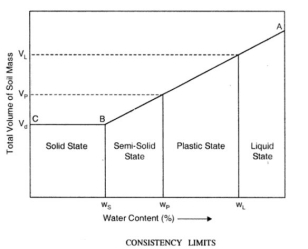
The boundary water contents at which the soil undergoes a change from one state to another are called Consistency Limits or Atterberg Limits, after the Swedish scientist Albert Atterberg who first demonstrated the significance of these limits.
B. Liquid Limit
The boundary water content between the liquid state and the plastic state is called the liquid limit. It is denoted by wL in the figure above. It indicates the stage when the sample changes from possessing no shearing strength to having infinitesimal shear strength.
Laboratory Test Procedure:
The liquid limit for a soil sample is determined using the Casagrande apparatus, as shown in figure below.
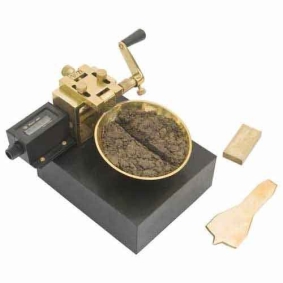
Based on this method, Liquid Limit is also defined as the soil water content at which a groove cut in a pat of soil by a grooving tool of standard dimensions will flow together for a distance of 13 mm under the impact of 25 blows in a standard liquid limit device.
a) A moistened sample of soil is put into the Casagrande cup and a ‘V’-shaped groove is cut into the sample using a standardized tool.
b) The cup is raised and dropped from a height of 10 mm, @ about 2 drops/second.
c) Stop when the bottom layer of soil forming the groove flows together for a distance of 13 mm.
d) The number of drops required to close the groove is noted down. This number must be between 15 and 35 drops, so we keep adjusting the water content of the soil sample until this is true.
e) The water content is then determined by the oven-drying method.
f) The experiment is repeated atleast three times to obtain the average value for the liquid limit.
C. Plastic Limit
The water content at which the soil sample changes from plastic state to semi-solid state is known as Plastic Limit. It is denoted by wP in the figure above. The soil loses its plasticity and behaves like a brittle material.
Plasticity of a material is defined as its ability to undergo deformation without cracking or fracturing.
Laboratory Test Procedure:
Based on the laboratory method, the plastic limit for a soil sample defined as the water content at which a soil would just begin to crumble when rolled into threads of approximately 3mm diameter.
a) Moisten a sample of sieved soil such that it can be easily rolled by your hands.
b) Roll the sample into an ellipsoid shape in your hands and put it on a hard, smooth surface. Now, roll the ellipsoid into a thread using your fingers. The aim is to roll it into a thread of around 3 mm diameter.
c) When the thread reaches the correct diameter, break it into pieces and knead it into an ellipsoid again. Then, re-roll into a 3 mm diameter thread.
d) Continue the process until the thread crumbles and cannot be re-shaped into a thread of required diameter.
e) Determine the water content of the crumbled soil sample by oven drying method.
D. Shrinkage Limit
It indicates the state when a decrease in the moisture content of the soil sample leads to no change in the volume of the soil mass. The sample changes from semi-solid to solid state.
Laboratory Test Procedure:
a) A mass of wet soil (M1) is placed in a porcelain dish 44.5 mm in diameter and 12.5 mm high, oven-dried and weighed again (M2).
b) Initial volume of wet soil is calculated from the dimensions of the porcelain dish (V1)
c) The volume of this oven-dried sample is determined by using mercury in a container and placing the oven-dried pat on it. The volume of mercury displaced is equal to the volume of the sample (V2).
d) The shrinkage limit is then calculated using the formula:
SL = 
e) Another parameter known as Shrinkage Ratio can also be determined from this test. Shrinkage ratio is ratio of volume change of soil as a percentage of the dry volume to the corresponding change in moisture content.
SR = 
E. Plasticity Index (Ip)
It indicates the range of moisture content over which a soil exhibits plasticity.
Ip = wL - wP
wL = water content at LL
wP = water content at PL
Clay soils possessing high values of liquid limit and plasticity index are referred to as highly plastic or fat clays and those with low values are known as lean clays.
For coarse-grained soils, there is no plastic state and their LL coincides with PL i.e., Ip = 0.
If PL ≥ LL, Ip is reported as zero.
Ip (%) | Soil description |
0 | Non plastic |
1 to 5 | Slight plastic |
5 to 10 | Low plastic |
10 to 20 | Medium plastic |
20 to 40 | Highly plastic |
>40 | Very highly plastic |
F. Consistency Index (Ic)
It is defined as the ratio of the difference between the liquid limit and the natural water content of the soil to its plasticity index.
Ic = 
If wN = wL then Ic = 0
If wN = wP then Ic = 1
If Ic < 0, the natural water content of soil (wN) is greater than the liquid limit (wL) and the soil mass behaves like a liquid but only upon disturbance.
If Ic > 1, soil is in semi-solid state and will be very hard and stiff.
G. Liquidity Index (IL)
It is the ratio of difference between the natural water content of a soil and its plastic limit to its plasticity index.
IL = 
If 0> IL > 1, soil is in plastic state.
H. Flow Index (If)
It is the slope of flow curve obtained between the number of blows and the water content in the Cassagrande test for the determination of liquid limit.
If = 
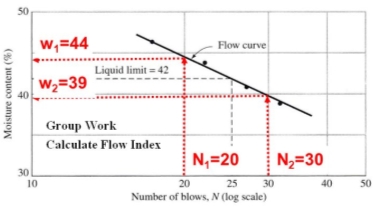
I. Toughness Index (It)
It is the ratio of plasticity index to flow index.
It = 
It gives an idea about the shear strength of soil at plastic limit.
For most soils, 0<It<3
When It >1, the soil can be easily crushed at the plastic limit.
J. Sensitivity (St)
It is defined as the ratio of the unconfined compressive strength of an undisturbed specimen of the soil to the unconfined compressive strength of a specimen of the same soil after remoulding at unaltered water content.
St = 
Soil classification based on sensitivity:
Sensitivity | Classification |
1-4 | Normal |
4-8 | Sensitive |
8-16 | Extra-sensitive |
>16 | Quick |
K. Activity (Ac)
It is the ratio of plasticity index to the % of clay size particles by weight.
Activity of clay Ac = 
Activity | Classification |
<0.75 | Inactive |
0.75 – 1.25 | Normal |
>1.25 | Active |
a) The liquid limit is an important index property that helps to predict the swelling and compressibility behaviour of fine-grained soils under loads.
In general, the higher the value of liquid limit of soil, the higher will be the swelling of the soil on wetting.
The compressibility of soil is a property which indicates the decrease in volume under loads and determines the settlement of structures. It has been observed that compressibility increases with the increase in the liquid limit of the soil.
b) The liquid limit and plasticity index are also useful in the classification of soils. The value of plasticity index and the plasticity chart are used to classify coarse-grained soils. Similarly, the liquid limit and the plasticity chart are used to classify fine-grained soils.
c) The liquid limit and plasticity index are used to indicate the type and amount of clay content in a soil sample. The higher the value of these two index properties, the higher will be the soil compressibility, swelling, and shrinkage.
d) Soils with higher value of plasticity index are expected to have a higher dry strength and lower permeability compared to soils with lower plasticity index, given that the value of their liquid limit is the same.
e) Higher the value of plasticity index of the soil, greater is the organic content in the soil.
f) Consistency index of the soil is an indicator of the shear strength of the soil sample. The unconfined compressive strength of the soil is directly proportional to the shear strength of soil.
g) The toughness index of the soil sample is inversely proportional to flow index.
h) Soils with larger flow index values lose their shear strength quickly with the increase in water content. Such soils cannot sustain heavy loads under high water content conditions.
i) Earthwork can be carried out easily when the water content of the soil is near its plastic limit.
j) The shrinkage limit of the soil is useful to estimate the settlement of structures due to seasonal drying of soils. The lower the shrinkage limit, the higher will be the value of settlement of structures.
k) A higher value of plasticity index is desirable for better workability and low permeability.
The purpose of soil classification is to arrange various types of soil into groups according to their engineering characteristics. For any classification system to be useful to engineers, it must fulfil the following three requirements:
- It should be simple to understand.
- It must have a limited number of groups.
- It must be based on the engineering properties which are relevant for the purpose.
Particle Size Classification System
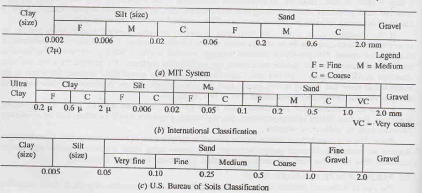

- Soils are arranged according to grain sizes.
- Terms such as gravel, sand, silt size and clay size are used to indicate or designate the particle sizes, but do not signify naturally occurring soil types since the naturally occurring soil is a mixture of particles of varying sizes.
- Please note that the fine grained particles are classified as silt size and clay size and not as silt and clay. Use of simply silt and clay indicates properties of plasticity and cohesion over a wide range of water content. However, clay size or silt size particles may not exhibit these properties. For example, rockflour is not plastic in nature but has particles of the size of clay particles.
- Therefore, this classification system may be apt for coarse-grained soils but can be misleading for fine-grained soils.
- Some of the classification systems based on particle-size are:
a) MIT System
b) International Classification System
c) U.S. Bureau of Soil Classification
d) Indian Standard (I.S.)Classification System
Textural Classification System
- Texture refers to the visual appearance of the material. It depends upon particle size, shape of the particles and their gradation.
- However, the Textural Classification System is the soil classification of composite soils based exclusively on Particle Size Distribution.
- The most popular and acceptable Textural Classification System is the triangular classification system suggested by U.S. Bureau of Public Roads.
- According to this, particles are classified as sand (0.05-2mm), silt (0.005-0.05mm) and clay (< 0.005mm). The percentage of sand, silt and clay are plotted along the 3 sides of an equilateral triangle, which is further divided into 10 zones, each indicating a type of soil.
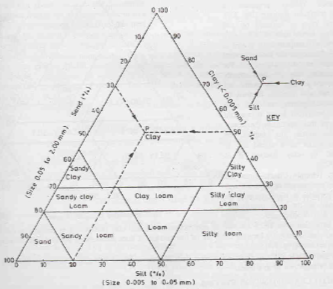
- For example, the point ‘P’ in the figure denotes a soil that contains 30% sand, 20% silt and 50% clay. Hence, this soil is classified as clay.
AASHTO Soil Classification System
- American Association of State Highway and Transportation Official (AASHTO) Classification System classifies soil for use on highways, based on particle size distribution and plasticity characteristics.
- Both coarse-grained and fine-grained soil is classified into 8 groups: A1 to A7 with an additional group A8 for peat or muck. A1 and A7 are further sub-divided into 2 categories, while A2 is sub-divided into 4 categories.
- In general, the lower is the group number the more suitable is soil for highway construction.
- Soils within each group are evaluated according to a Group Index (GI) calculated as follows:
GI = 0.2a + 0.005ac + 0.01bd
Where, a = % passing through 75µ sieve greater than 35 but not exceeding 75 as a whole number (0 to 40)
b = % passing through 75µ sieve greater than 15 but not exceeding 55 as a whole number (0 to 40)
c = that portion of numerical liquid limit greater than 40 but not exceeding 60 as a whole number (0 to 20)
d = that portion of numerical plasticity index greater than 10 but not exceeding 30 as a whole number (0 to 20)
- Greater the value of GI, the less desirable is soil for highway construction within that sub-group.
- If GI < 0, it is reported as 0.
- If GI = 0-2: good sub-grade material
- If GI ≥ 2: poor sub-grade material
Unified Soil Classification System (USCS)
- USCS was first developed by A. Cassagrande for the purpose of air-field construction during WW-II. However, it was later modified by Bureau of Reclamation and Corps of Engineers of USA to be applicable to dams, foundations etc.
- It is the most popular system. It classifies coarse-grained soils on the basis of their grain size distribution and the fine-grained particles on the basis of their plasticity characteristics. The symbols used for various soil types in USCS are shown in the table below.
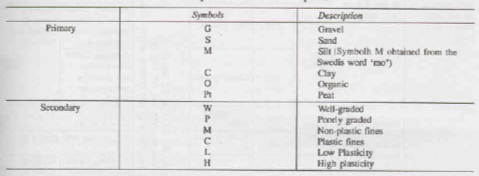
The soil is first classified into 3 categories:
- Coarse-grained soils: These are soils having 50% or more being retained on 0.075 mm sieve. They are further classified into 8 groups.
- These are termed as gravel (G) if 50% or more of coarse fraction is retained on 4.75 mm sieve otherwise it is called sand (S).
- Furthermore, if this soil contains less than 5% fines, which is well-graded (W), it is termed as GW or SW. However, if it is poorly graded (P), the soil is designated GP or SP.
- If the soil contains more than 12% fines, it may be designated as GM, GC, SM or SC where M stands for silt and C stands for clay.
- If fines are in the range of 5 to 12%, they may be termed as GW-GM, SP-SM etc.
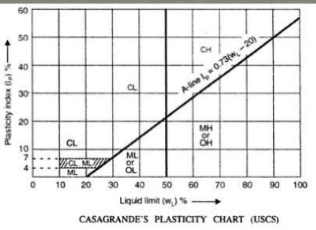
2. Fine-grained soils: If 50% or more passes through 0.075 mm sieve, it is termed as fine-grained soil. They are further classified into 6 groups.
- These are further sub-divided into two types:
a) Soils of low compressibility (L) if liquid limit ≤ 50% and are designated the symbols ML, CL, OL. (O stands for organic)
b) Soils of high compressibility (H) if liquid limit > 50% and are designated the symbols MH, CH, OH.
- The exact type of soil is determined from the plasticity chart, in which the A-line separates the clays from the silts. The equation for A-line is as follows:
IP = 0.73 (wL – 20)
- If the value of IP ranged from 4 to 7, then dual symbols are used.
- When the soil is oven-dried and its liquid limit decreases by more than 30%, it is classified as organic (OL, OH). Otherwise, it is inorganic (ML, MH).
3. Highly organic soils: It is identified by visual inspection. It is also known as Peat (Pt).
Indian Standard Soil Classification System (ISSCS)
- It is based on USCS with the modification that fine-grained soils are sun-divided into 3 groups of low, medium and high compressibility, instead of 2 groups as in the case of USCS.
Low compressibility (L): LL < 35
Medium compressibility (I): 35 < LL < 50
High compressibility (H): LL > 50
- The soil is classified into 18 groups: 8 groups of coarse-grained, 9 groups of fine-grained and 1 group of Peat.
- The basic soil components as per ISSCS are as shown in the table below.
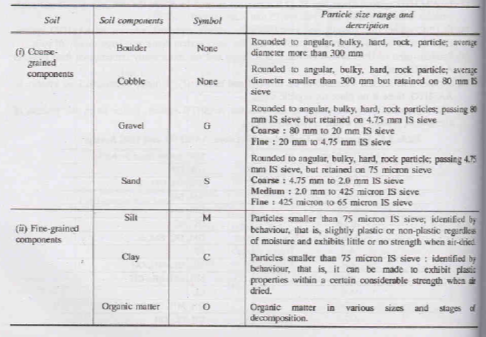
Indian Standard Soil Classification System (ISSCS) recommends the following tests for field identification of soil:
a) Visual Examination
We first try to classify the soil as coarse-grained or fine-grained simply by looking at it.
We take the soil sample and spread it on a flat surface.
If the grains are visible to the naked eye, the soil is coarse-grained but if the particles are microscopic and not visible to the naked eye, the soil is termed fine-grained.
If the soil contains more than 50% of visible particles, then it is coarse grained soil and if it contains less than 50% of visible particles then it is termed as fine grained soil.
b) Dispersion Test
Fine sand cannot be easily distinguished from silt by simple visual examination.
The dispersion test consists of pouring a spoonful of sample in a jar of water. If the material is sand, it will settle down in 1-2 mins but if it is silt, it may take up to 15 mins to settle down.
In either case, nothing may be left in the suspension ultimately.
c) Dilatancy or Shaking Test
A part of the material is shaken after placing it in the palm.
If it is silt, water comes to the surface and gives the sample a shining appearance. If it is kneaded, the moisture will re-enter the soil and the shine will disappear.
If it is clay, the water cannot move easily and the material will appear dark.
If it is a mixture of silt and clay, the relative speed with which the shine appears indicates the amount of silt present.
d) Dry Strength Test
A small briquette of material is prepared and dried. Then, one has to try and break it.
If it breaks easily, the material is silt. Also, in case of silt, one can easily brush off loose material from the surface of the briquette.
If it requires effort to break, it is clay. Clay has a sloppy touch. It sticks, dries slowly and cannot be dusted off easily.
e) Rolling or Toughness Test
A thread of diameter 3 mm is attempted to be made out of moist soil sample.
If the material is silt, it is not possible to make a thread without disintegration and crumbling of the material.
If it is clay, such a thread as long as 30 cm can be supported by its own weight when held at the ends.
f) Organic Content and Colour
Fresh, wet organic soil usually has a distinct odour of decomposed organic matter, which can be easily detected on heating. Such soils also have dark colour.
Reference Books:
1) A.S.R. Rao and Gopal Ranjan -“Basic and Applied Soil Mechanics” – New Age International, 2007
2) A.K. Jain and B.C. Punmia- “Soil Mechanics and Foundations” – Laxmi Publications